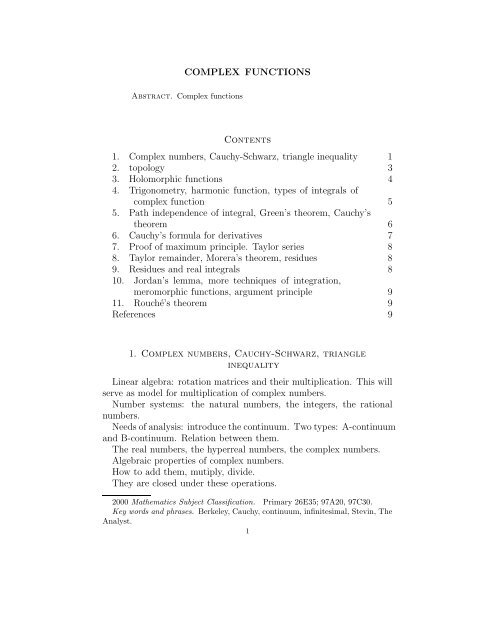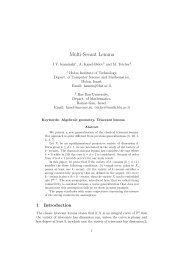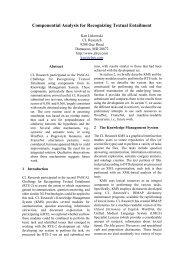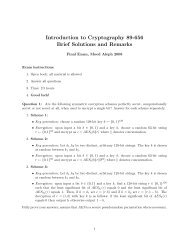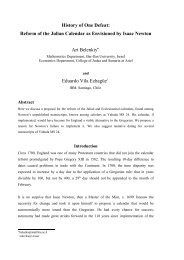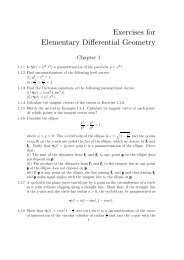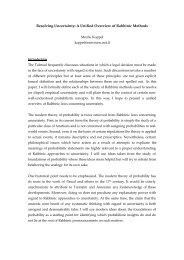COMPLEX FUNCTIONS Contents 1. Complex numbers, Cauchy ...
COMPLEX FUNCTIONS Contents 1. Complex numbers, Cauchy ...
COMPLEX FUNCTIONS Contents 1. Complex numbers, Cauchy ...
You also want an ePaper? Increase the reach of your titles
YUMPU automatically turns print PDFs into web optimized ePapers that Google loves.
<strong>COMPLEX</strong> <strong>FUNCTIONS</strong><br />
Abstract. <strong>Complex</strong> functions<br />
<strong>Contents</strong><br />
<strong>1.</strong> <strong>Complex</strong> <strong>numbers</strong>, <strong>Cauchy</strong>-Schwarz, triangle inequality 1<br />
2. topology 3<br />
3. Holomorphic functions 4<br />
4. Trigonometry, harmonic function, types of integrals of<br />
complex function 5<br />
5. Path independence of integral, Green’s theorem, <strong>Cauchy</strong>’s<br />
theorem 6<br />
6. <strong>Cauchy</strong>’s formula for derivatives 7<br />
7. Proof of maximum principle. Taylor series 8<br />
8. Taylor remainder, Morera’s theorem, residues 8<br />
9. Residues and real integrals 8<br />
10. Jordan’s lemma, more techniques of integration,<br />
meromorphic functions, argument principle 9<br />
1<strong>1.</strong> Rouché’s theorem 9<br />
References 9<br />
<strong>1.</strong> <strong>Complex</strong> <strong>numbers</strong>, <strong>Cauchy</strong>-Schwarz, triangle<br />
inequality<br />
Linear algebra: rotation matrices and their multiplication. This will<br />
serve as model for multiplication of complex <strong>numbers</strong>.<br />
Number systems: the natural <strong>numbers</strong>, the integers, the rational<br />
<strong>numbers</strong>.<br />
Needs of analysis: introduce the continuum. Two types: A-continuum<br />
and B-continuum. Relation between them.<br />
The real <strong>numbers</strong>, the hyperreal <strong>numbers</strong>, the complex <strong>numbers</strong>.<br />
Algebraic properties of complex <strong>numbers</strong>.<br />
How to add them, mutiply, divide.<br />
They are closed under these operations.<br />
2000 Mathematics Subject Classification. Primary 26E35; 97A20, 97C30.<br />
Key words and phrases. Berkeley, <strong>Cauchy</strong>, continuum, infinitesimal, Stevin, The<br />
Analyst.<br />
1
2 <strong>COMPLEX</strong> <strong>FUNCTIONS</strong><br />
The operation of taking complex conjugate.<br />
Show that conjugation is an isomorphism in that it ”preserves addition<br />
and multiplication”.<br />
Real poly which vanishes at a complex number also vanishes at its<br />
conjugate.<br />
Hence complex roots of a real polynomial come in (conjugate) pairs.<br />
Introduce diagram of complex number in the plane:<br />
x + iy.<br />
Polar coordinates (kotbiot, as in kotev=pole) representation:<br />
(r, θ).<br />
As far as the argument (theta) of a complex number is concerned,<br />
there is an important distinction between arg and ARG, as follows: the<br />
argument (zavit) is multiple-valued (rav arki) is denoted “arg” (lower<br />
case letters), while the function “ARG” (capital letters) is the principal<br />
value branch with values in the interval<br />
[−π, π).<br />
This principal part (ha’anaf ha’ikari) is discontinuous on the negative<br />
real axis.<br />
The representation<br />
Use the following notation:<br />
z = x + iy = r(cos θ + i sin θ).<br />
z = rcis(θ).<br />
Check the magic multiplication formula.<br />
Also n-th power: argument gets multiplied by n, giving de Moivre’s<br />
formula:<br />
(cis(x)) n = cis(nx).<br />
Also when divide, there is a corresponding formula with subtraction<br />
of angles.<br />
The root: find n-th root in a straightforward way. How many? There<br />
are n of them.<br />
The absolute value (erech muchlat)<br />
From this you can prove that<br />
|z| 2 = z · z.<br />
|zw| = |z||w|,<br />
or you can use the polar representation.
The real part:<br />
The imaginary part:<br />
<strong>COMPLEX</strong> <strong>FUNCTIONS</strong> 3<br />
x = (z + z)/2.<br />
y = (z − z))/2i.<br />
NB: what’s called the ”imaginary part” is a REAL number.<br />
Theorem <strong>1.</strong><strong>1.</strong> <strong>Cauchy</strong>-Schwarz inequality:<br />
Re (z 1 z 2 ) ≤ |z 1 ||z 2 |.<br />
Prove triangle inequality from <strong>Cauchy</strong>-Schwarz.<br />
Fundamental theorem of algebra: every nonconstant real polynomial<br />
has a complex root.<br />
Furthermore, every nonconstant complex polynomial has a complex<br />
root.<br />
This enables us to factor every polynomial into linear factors. Namely,<br />
we start with long division of polynomials. Dividing p(z) by (z − z 0 ),<br />
we obtain<br />
p(z) = q(z)(z − z 0 ) + c<br />
where c is a constant. If z 0 is a root, we must have c = 0. Thus every<br />
polynomial can be factored as<br />
n∏<br />
p(z) = c (z − z k ).<br />
k=1<br />
If p(z) is real, then we use the following formula:<br />
(z − z 0 )(z − z 0 ) = z 2 − 2Re(z 0 )z + |z| 2 .<br />
Theorem <strong>1.</strong>2. Every real polynomial p(z) factors as a product of two<br />
products as follows:<br />
(n−m)/2<br />
m∏ ∏<br />
p(z) = (z − z k ) (z 2 + a l z + b l ),<br />
k=1<br />
where the roots z k are real and the coefficients a l and b l are real.<br />
l=1<br />
2. topology<br />
Distance function between z 1 , z 2 ∈ C:<br />
d(z 1 , z 2 ) = |z 1 − z 2 | = √ (x 1 − x 2 ) 2 + (y 1 − y 2 ) 2 .<br />
Basic neighborhood<br />
deleted neighborhood (sviva menukevet)<br />
bounded set<br />
compact set: (a) finite subcover; (b) closed and bounded.
4 <strong>COMPLEX</strong> <strong>FUNCTIONS</strong><br />
When is a set not connected?<br />
For open sets, “connected” is equivalent to “path-connected”.<br />
Series and sequences<br />
<strong>Cauchy</strong> sequences<br />
partial sums<br />
Definition of absolute convergence of series<br />
notion of path z(t)<br />
velocity z ′ (t) = x ′ (t) + iy ′ (t)<br />
Continuity<br />
Definition of derivative<br />
Rules of differentiation<br />
Definition 2.<strong>1.</strong> A polynomial p(z) is a function of the form p(z) =<br />
∑<br />
k a kz k .<br />
Remark 2.2. Note that a 2-variable real polynomial q(x, y) in the real<br />
part x and the imaginary part p is not a “polynomial” in our complex<br />
sense.<br />
Rational function<br />
Function z is not differentiable.<br />
3. Holomorphic functions<br />
Example 3.<strong>1.</strong> The function |z| 2 is not differentiable.<br />
Theorem 3.2 (<strong>Cauchy</strong>-Riemann equations). Let z = x + iy, and let<br />
f(z) = u(x, y) + iv(x, y).<br />
Assume the complex function f is differentiable at z. Then the following<br />
relations among partial derivatives are satisfied:<br />
and<br />
∂u<br />
∂x = ∂v<br />
∂y<br />
∂u<br />
∂y = −∂v ∂x .<br />
Definition of analytic/holomorphic function.<br />
exponential function.<br />
log.<br />
principal branch of log.
<strong>COMPLEX</strong> <strong>FUNCTIONS</strong> 5<br />
4. Trigonometry, harmonic function, types of integrals<br />
of complex function<br />
<strong>Complex</strong> trigonometric functions in terms of the complex exponential<br />
function.<br />
The Jacobian J f of a holomorphic function w = f(z) = u(x, y) +<br />
iv(x, y) of independent variable z = x + iy has the form<br />
)<br />
J f =<br />
( ∂u<br />
∂x<br />
∂v<br />
∂x<br />
∂u<br />
∂y<br />
∂v<br />
∂y<br />
which can be written in terms of the partials of u alone<br />
J f =<br />
( ∂u<br />
∂x<br />
∂u)<br />
∂y<br />
− ∂u<br />
∂y<br />
∂u<br />
∂x<br />
(4.1)<br />
(4.2)<br />
by exploiting the <strong>Cauchy</strong>-Riemann equations.<br />
The matrix J f is proportional to a rotation matrix. Namely, J f is<br />
multiplication by the complex scalar<br />
f ′ (z) = ∂u<br />
∂x + i∂v ∂x .<br />
Here u and v are both harmonic functions.<br />
Definition 4.<strong>1.</strong> Harmonic functions are functions in the kernel of the<br />
Laplace operator ∆ = ∂2<br />
+ ∂2<br />
.<br />
∂x 2 ∂y 2<br />
Real and imaginary parts of a holomorphic function are harmonic.<br />
Definition 4.2. The conjugate harmonic function.<br />
Example 4.3. The function log(x 2 + y 2 ) does not have a GLOBAL<br />
harmonic conjugate.<br />
Definition 4.4. integral of a complex function of a real variable.<br />
Definition 4.5. Integral of a complex function of a complex variable<br />
(a line integral).<br />
Properties of integrals, defined as Riemann sums. linear, additive,<br />
etc.<br />
Estimate above in terms of upper bound on function.<br />
Discussion of path −γ with the opposite orientation. Reversal of<br />
orientation changes the sign of the integral:<br />
∫<br />
∫<br />
f(z)dz = − f(z)dz.<br />
−γ<br />
γ
6 <strong>COMPLEX</strong> <strong>FUNCTIONS</strong><br />
Definition 4.6. Integral with respect to arclength (orech hakeshet):<br />
∫<br />
f(z)|dz|.<br />
Note that reversing orientation of the path does not affect ∫ f(z)|dz|.<br />
Basic properties of path integral and of integral with respect to arclength.<br />
5. Path independence of integral, Green’s theorem,<br />
<strong>Cauchy</strong>’s theorem<br />
A complex analog of the fundamental theorem of calculus:<br />
Theorem 5.<strong>1.</strong> If f(z) has a primitive F (z) (i.e., F ′ (z) = f(z)), then<br />
the path integral of f is independent of path, and equals<br />
∫<br />
f(z)dz = F (z 2 ) − F (z 1 ).<br />
Converse theorem:<br />
Theorem 5.2 (Morera’s theorem). If a function f has an integral that<br />
is path-independent in a path-connected domain, then there exists a<br />
holomorphic function F (z) such that F ′ (z) = f(z).<br />
Recall Green’s theorem.<br />
Theorem 5.3 (<strong>Cauchy</strong>’s theorem). If a closed Jordan curve γ bounds<br />
a simply connected domain D, if f holomorphic in D and its boundary,<br />
then integral over the boundary of f(z) vanishes: ∮ f(z) = 0.<br />
γ<br />
<strong>Cauchy</strong>’s theorem is proved using Green’s theorem.<br />
More general Green domains where the theorem is applicable: domains<br />
with several boundary components.<br />
A key assumption is that f ′ is continuous.<br />
Example 5.4. The integral ∮ 1dz ≠ 0 but rather 2π because the<br />
|z|=1 z<br />
function is not holomorphic inside the Jordan curve.<br />
Theorem 5.5 (<strong>Cauchy</strong>-Goursat formula, or <strong>Cauchy</strong> integral formula).<br />
Let D ∈ C be a domain bounded by outside loop γ 1 and inside loops γ 2 , . . . γ n .<br />
All loops are oriented counterclockwise.<br />
Let f be holomorphic in ¯D. Then for each z ∈ D,<br />
f(z) = 1<br />
2πi<br />
∫<br />
γ 1<br />
f(w)<br />
n∑<br />
w − z dw − 1<br />
2πi<br />
k=2<br />
∫<br />
γ k<br />
f(w)<br />
w − z dw.
<strong>COMPLEX</strong> <strong>FUNCTIONS</strong> 7<br />
Theorem 5.6 (Laurent series). If f(z) is holomorphic in an annulus<br />
¯D = {z : 0 < r 1 ≤ |z| ≤ r 2 }<br />
then for each z ∈ D we have<br />
f(z) =<br />
∞∑ b n<br />
z + ∑ ∞<br />
a n n z n .<br />
n=1<br />
Proof using geometric series. Proof uses change of order of integration<br />
and sum. This step will be justified later.<br />
n=0<br />
6. <strong>Cauchy</strong>’s formula for derivatives<br />
Theorem 6.1 (Generalisation of <strong>Cauchy</strong>’s theorem). Let D ∈ C be<br />
a domain bounded by outside loop γ 1 and inside loops γ 2 , . . . γ n . We<br />
orient the outside loop counterclockwise, and the inside loops clockwise.<br />
Then<br />
n∑<br />
∫<br />
f(z)dz = 0.<br />
γ k<br />
k=1<br />
Here is a special case of the formula proved in the last section.<br />
Theorem 6.2 (<strong>Cauchy</strong>’s formula). Let D ∈ C be a domain bounded by<br />
Jordan curve γ, oriented counterclockwise. Let f be holomorphic in ¯D.<br />
Then for each z 0 ∈ D,<br />
f(z 0 ) = 1 ∫<br />
2πi γ<br />
Proof. Use infinitesimal loop around z 0 .<br />
f(z)<br />
z − z 0<br />
dz.<br />
Theorem 6.3 (Formula for the derivative). Let D ∈ C be a domain<br />
bounded by Jordan curve γ, oriented counterclockwise. Let f be holomorphic<br />
in ¯D. Then for each point z ∈ D,<br />
f ′ (z) = 1<br />
2πi<br />
∫<br />
γ<br />
f(w)<br />
(w − z) 2 dw.<br />
Corollary 6.4. Let D ∈ C be a domain bounded by Jordan curve γ,<br />
oriented counterclockwise. Let f be holomorphic in ¯D. Then for each<br />
point z ∈ D, f is differentiable infinitely many times at z, and<br />
f (n) (z) = n!<br />
2πi<br />
∫<br />
γ<br />
f(w)<br />
dw.<br />
(w − z)<br />
n+1<br />
Theorem 6.5 (<strong>Cauchy</strong> estimate). Suppose f is holomorphic in a disk<br />
of radius R centered at a. Assume |f| is bounded by M > 0. Then<br />
|f (n) (a)| ≤ Mn!<br />
R n .<br />
□
8 <strong>COMPLEX</strong> <strong>FUNCTIONS</strong><br />
Theorem 6.6 (Liouville’s theorem). An bounded entire function is<br />
constant.<br />
Theorem 6.7 (Fundamental theorem of algebra). A nonconstant complex<br />
polynomial has a root.<br />
Lemma 6.8. If the maximum of |f(z)| is attained at the center of a<br />
disk then the founction is constant on the boundary.<br />
Theorem 6.9 (Maximum principle). (a) a holomorphic function in an<br />
open domain does not attain a maximum; (b) if it is holomorphic on<br />
the closure, the maximum is attained at the boundary.<br />
Proof will be given next week.<br />
7. Proof of maximum principle. Taylor series<br />
Taylor series.<br />
Taylor with remainder for the geometric series.<br />
Examples: exponential, sine, cosine, what happens with log.<br />
Definition of the order of a zero of a holomorphic function.<br />
8. Taylor remainder, Morera’s theorem, residues<br />
Use Taylor with remainder to prove the Taylor expansion of f(z),<br />
using estimate on the remainder term (36’).<br />
Recall Morera’s theorem (see Theorem 5.2).<br />
Isolated zero theorem.<br />
Theorem on uniqueness of analytic functions.<br />
Proof of addition formulas for trig functions of a complex variable<br />
using uniqueness (38’).<br />
Thorny example of (2 a ) b (39’ of the new batch).<br />
Singularities, poles, residues<br />
Theorem 8.1 (Weierstrass). Suppose f has an essential singularity<br />
at z 0 . Let S be an arbitrary open neighborhood of z 0 . Then for every<br />
a ∈ C, the set of values f(S) contains points arbitrarily close to a.<br />
9. Residues and real integrals<br />
Applying the technique of residues to the calculation of real integrals.<br />
Integrals over R.<br />
Trigonometric integrals over [0, 2π].<br />
Three techniques for finding real integrals by means of residues.
<strong>COMPLEX</strong> <strong>FUNCTIONS</strong> 9<br />
10. Jordan’s lemma, more techniques of integration,<br />
meromorphic functions, argument principle<br />
Jordan’s lemma<br />
Additional techniques of integration<br />
meromorphic functions.<br />
Residue of f ′<br />
at z f 0 gives the order of the zero if z 0 is a zero of f. If<br />
z 0 is a pole of f, then the residue of f ′<br />
at z f 0 gives minus the order of<br />
the pole.<br />
Winding number (index) of a closed curve (not necessarily a simple<br />
loop).<br />
argument principle.<br />
1<strong>1.</strong> Rouché’s theorem<br />
Theorem 1<strong>1.</strong><strong>1.</strong> Let D ⊂ C be a domain bounded by a Jordan curve.<br />
If complex-valued functions f and g are holomorphic in the closure of<br />
D, with |g(z)| < |f(z)| for all z ∈ D, then f and f + g have the same<br />
number of zeros inside D counted with multiplicity.<br />
References<br />
[1] Bair, J.; Henry, V.: Implicit Differentiation with Microscopes. The Mathematical<br />
Intelligencer 32 (2010), no. 1, 53–55.<br />
[2] Churchill, Ruel V.; Brown, James Ward: <strong>Complex</strong> variables and applications.<br />
Fourth edition. McGraw-Hill Book Co., New York, 1984.<br />
[3] Churchill, Ruel V.: <strong>Complex</strong> variables and applications. 2nd ed. McGraw-Hill<br />
Book Co., Inc., New York-Toronto-London 1960.<br />
[4] Conway, John B.: Functions of one complex variable. Second edition. Graduate<br />
Texts in Mathematics, 1<strong>1.</strong> Springer-Verlag, New York-Berlin, 1978.


